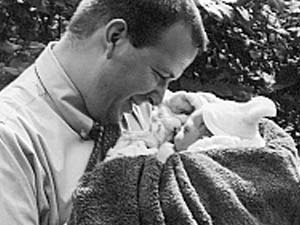So many women I talk to worry about giving birth unexpectedly at home. I always reassure them that babies rarely come so quickly that there isn’t time to get to the hospital, if that is what they’ve planned to do. And I once had a nurse midwife tell me that babies that arrive that quickly usually do so because there’s nothing complicating their delivery and that in fact it’s a sign that the birth is going just fine. Whether or not it’s true, I like the sentiment of it.
I came across this article about giving birth in a car recently. It uses every opportunity possible to reinforce the popular notion that birth is a crisis: “Now bent over and screaming, Carolyn could barely walk. Ram did his best to carry her without adding further pain and hoisted her into the front seat of his Suburban, all the while she was screeching out at the top of her lungs.” It concludes, “This week, Carolyn and Ram Miller met the firemen of Station 69 and gave them all a big hug for their heroic efforts and calming nature in what was a very traumatic moment.”
Gosh, gals! Where would we be without men? In fairness, the article was written by a male friend of the family, not a journalist. But that makes his characterization of birth all the more relevant. I think this is the “car birth myth” most women hear and believe.
If you know of any scared women, please refer them to this car birth story.
Earlier this fall my friend and fellow doula Terri worked with a client, Lisa. Lisa's first birth, daughter Jane, happened very, very soon after Lisa got to the hospital. So when Lisa called Terri to say that her water had broken, Terri made tracks to Lisa’s house.
Terri found Lisa draped over a birth ball moaning deeply during and resting calmly after her contractions. Almost immediately, the contractions became more intense and closer together. This coincided with the hurried arrival of Lisa's husband, Brian, who was in the middle of teaching music class. Everyone agreed it was time to head to the hospital.
Terri reports that when Lisa stood up to go to the car she had a loud and long contraction and sprinted to the car. (Or was it that she started sprinting and then had the contraction?) Either way, as soon as she got to the car she said those eyebrow-raising words “I feel like I have to go to the bathroom.”
It was then that Terri went in to dial 9-1-1. When she came out to look at the house number (after all, you have to know where to send the ambulance) Brian said “The head is out.”
Golly if it wasn’t. Brian asked Terri if that was o.k. Terri said yes. What else do you say? You can’t exactly put the head back in. Terri said “With your next push, Lisa, you’ll deliver the baby,” which is exactly what happened, right into Brian’s hands.
Terri said the 9-1-1 operator kept insisting that she suction the baby, with a turkey baster if necessary, but the baby was crying heartily and Lisa immediately put her to the breast.
Around that time Terri heard the sirens. Both an ambulance and a fire truck showed up. But everything was already under control. All they did was help Lisa out of her Subaru and into the ambulance for a ride to the hospital ex post facto.
These photos clearly show that mom, dad and baby Claire were not traumatized in the least. In fact, have you ever seen a mother more radiant?

Lisa says, “There was no fear during that hour prior to birth, just focus. I attribute that attitude to God's grace, but in very real terms too, the confidence to trust my body that came directly from the knowledge I received from the Bradley Method. When Terri did arrive, certainly, I was VERY glad to see her! And this allowed me to let my body continue the labor in such an efficient way. Certainly, we were blessed that there were no complications and we can cherish the memory of our beautiful daughter saying, ‘here I am’ right outside our front door!”

Here we see Brian meeting his new daughter in the sunshine of a September day.
Incidentally, an ancillary benefit to this birth – at least in the hospital where Lisa went – was that hospital staff would not remove her baby from the room for any of the usual reasons. In fact a nurse midwife who works there told me babies born outside the hospital are considered “contaminated” and are therefore not allowed to mix with other babies or facilities.
Thank you to Lisa and Brian for letting me share their story and photos and to Terri for taking the beautiful pictures.








